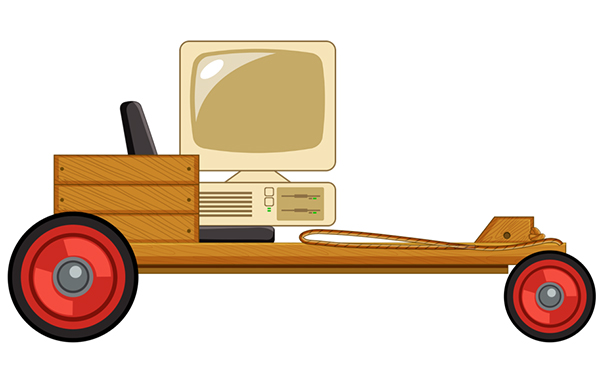Insurance Technology Diary
Episode 59: A tale of two reasons
Guillaume Bonnissent’s Insurance Technology Diary

I guess I’m responsible for my son’s extraordinary ambitions about building motor cars. They began within the bounds of reason, born of his fascination with F1 (for which I suppose I am also to blame). They were fuelled by my repeated assertions that he can achieve anything he wants. No father should regret such positive encouragement, even if it isn’t quite true.
The ambitions grew with my proposal that we build a soapbox car together, as a father-and-son bonding exercise. Victory in the neighbourhood Derby was the target. Little did I realise that his fascination with making vehicles would overpower the more conventional desire to win, and that his automotive engineering ambitions would soon extend very much further than a downhill racer made from an old pram.
The next project was a pedal-powered go-kart. This in practice involved only splicing pieces from his now-too-small bicycle into the previously loved soapbox contender. He spent a good couple of weeks powering around the rec pulling doughnuts before announcing this this, too, was unsatisfactory. We would build a fully functioning car with a petrol engine, he insisted. (I say we, since Dad was to be inextricably bound to the development project.)
He’s 12. His mother pointed out that it would be years before he would be legally allowed to drive, but that just convinced him that this was a project not to be rushed.
The long lead time was one of only two positives I can summon for the project’s prospects, the other being the underutilised garage at the back of our garden. The list of negatives, on the other hand, comprises a daunting set of realities:
- I have appropriate tools to change a tap, but not to build an automobile.
- Neither I nor my son are experienced mechanics.
- Cars comprise a very large number of bits and pieces.
The only way I could think of to get all of the right parts to make a car was to buy an intact one. My son objected that to do so would reduce our project to a mundane exercise in dismantling and reassembly, rather than one of building.
Point taken. I conceded. The build was to proceed.
I triumphed, at least, in the debate about how to commence. We acquired the chassis of an old Ford Fiesta, a make and model for which parts are readily available. The nearby scrapyard has since become a familiar destination for my son and me.
Whilst we travelled there recently for the umpteenth time to acquire yet another now-necessary widget (and here, patient reader, I will get to the point), I recalled the numerous professional conversations I’ve had about the choice between initiating and executing an inhouse platform build, and buying insurance technology direct from a vendor. My position in such discussions is always the same.
If you want tested technology that works, has been customised to suit your business, is made operational on time, and built by specialists with lots of experience, without an open-ended cost commitment, and causing only minimal distraction to your IT department (who probably have no spare time anyway), don’t even think about building your own insurance tech.
But for me, a more difficult, reflective question remained. How do I manage to convince clients, over whom I have no patriarchal influence, of the benefits of buy over build, when I cannot even sway my own son?
The penny finally fell. MGAs, brokers, and insurers spend money on new platforms to improve their business outcomes, and ultimately to increase their profitability. My son’s motivation, in stark contrast, is the sheer pleasure of the build.
Plus, his parameters are different. Money is no object, since the Bank of Dad provides the lion’s share of the finance. Time is unlimited, too. He wants something to test-drive by age 15¾, when he can apply for a learner’s permit, but that to him seems like a lifetime away. Within those simple factors, our car-building project has faced no pressures sufficient to prevent it from getting the steady green light.
Still, I remain constantly aware of a single significant obstacle that will ultimately prevent the conventional success of the project. Call it the Lancia HF logo in the room. Our car will never be fit for purpose. Neither the experience nor expertise exists on the pit team to get it done, no matter how much he wants it. Even if we can get the engine to turn over and the wheels to turn, no car built by unpractised amateurs will ever go as fast as he wants, or as safely as his mother insists. And even if, against all the odds, we get it working perfectly, it will still be a Ford Fiesta.
I stand as the exception proving the rule, but real-world underwriters take very little pleasure from the construction of underwriting platforms. True, they are almost always overjoyed to use a system that’s exceptionally good, they delight in software that has been tuned to precision to satisfy their needs, and they cheer when new functionality they’ve asked for is introduced to make their job easier, but such platforms are almost certainly built by experienced specialists who really, really enjoy it.
